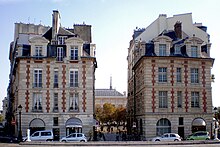Place Dauphine
 The Place Dauphine in 2018 | |
| Length | 102 m (335 ft) |
|---|---|
| Width | 12 to 67 m (39 to 220 ft) |
| Arrondissement | 1st |
| Quarter | Saint-Germain-l'Auxerrois, Île de la Cité |
| Coordinates | 48°51′23.54″N 2°20′32.74″E / 48.8565389°N 2.3424278°E |
| From | Rue de Harlay |
| To | Rue Henri Robert |
| Construction | |
| Completion | 1607-1616[1] |
| Denomination | 1607-1792, then 1814 |
The Place Dauphine is a public square located near the western end of the
History

The Place Dauphine was laid out in 1607–10, when the Place Royale was still under construction. It was among the earliest city-planning projects of Henri IV, and was on a site created from part of the western garden of the walled enclave known as the

(north is toward the lower left)
Approximately 3 acres of land was conveyed to
The last of the houses to be constructed (at the southeast corner of the square) was finished in 1616.
Since its construction, almost all of the houses surrounding the square have been raised in height, given new facades, rebuilt, or replaced with imitations of the originals. Only two retain their original appearance, those flanking the entrance facing the Pont Neuf.[9] In 1792 during the Revolution the Place Dauphine was renamed Place Thionville, a name it retained until 1814.[10] The former eastern range, heavily damaged by fire during the fighting of the Paris Commune of 1871, was swept aside to open the view toward the Palais de Justice.[9]
Gallery
-
The Place Dauphine looking west toward the Pont Neuf
-
The Place Dauphine, north side
Metro station
The Place Dauphine is:
| Located near the Cité .
|
It is served by lines 4 and 7.
References
Notes
- ^ According to Ballon 1991, pp. 125, 155, Henry IV approved the name and the design of the square in May 1607, and the last house was completed in 1616.
- ^ Place is feminine, not dauphin.
- ^ Ballon 1991, pp. 114–117, 122, 124.
- ^ Ballon 1991, pp. 125–127
- ^ Ballon 1991, p. 155.
- ^ Blunt 1999, p. 104, states that these features were made of stucco, while Ayers 2004, p. 27, and Ballon 1991, p. 144, say they were stone.
- ^ Ballon 1991, p. 152.
- ^ Ballon 1991, p. 154–157.
- ^ a b Ayers 2004, 27.
- ^ Boursin & Challamel 1893, p. 822.
Sources
- Ayers, Andrew (2004). The Architecture of Paris. Stuttgart; London: Edition Axel Menges. ISBN 978-3-930698-96-7.
- Ballon, Hilary (1991). The Paris of Henri IV: Architecture and Urbanism. Cambridge, Massachusetts: The MIT Press. ISBN 978-0-262-02309-2.
- Blunt, Anthony (1999). Art and Architecture in France, 1500–1700, fifth edition revised by Richard Beresford. New Haven: Yale University Press. ISBN 978-0-300-07748-3(paperback).
- Boursin, Elphège; Challamel, Augustin (1893). Dictionnaire de la Révolution française. Paris: Librairie Furne. View at Google Books.
External links
- La Place Dauphine
 Media related to Place Dauphine at Wikimedia Commons
Media related to Place Dauphine at Wikimedia Commons



